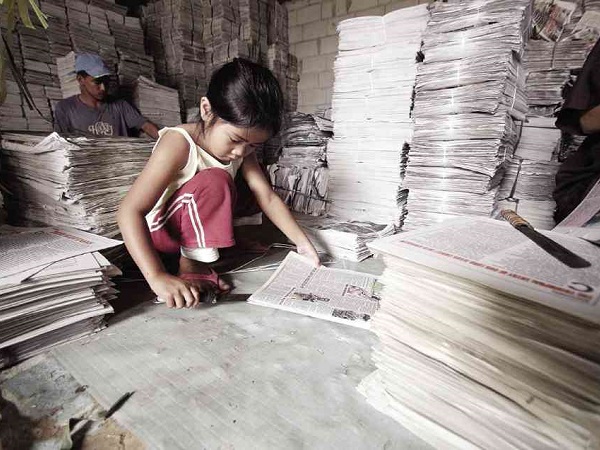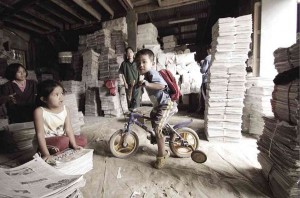Helping the young find the right jobs

A YOUNG girl helps her parents cut up unsold newspapers in La Trinidad, Benguet. The bundles of newspapers are then packed into bundles to be sold as packaging materials for Benguet vegetables. The family can sell a bundle for P70. PDI-NL/Richard Balonglong
BAGUIO CITY—Many children dream of becoming scientists and professionals, but their future careers used to be defined by the work they did for the family to help bring food to the table.
Farmers used to teach their sons and daughters how to manage their rice fields. Shop owners required their children to mind the store.
But today’s child labor law and a more assertive campaign for child rights have made that form of job apprenticeship politically unacceptable, so the government and the private sector have been redefining ways of introducing the youth to the “world of work,” says Romelda Escano, Baguio labor and employment officer.
The First Quarter Pinoy Youth Barometer Project of the Asian Institute of Management (AIM), which was released here in March, shows that the youth start to consider their job prospects as early as high school, with at least 40 percent of high school and college students surveyed indicating that their future lies in work abroad. The survey had 200 college students and 100 high school students from 13 campuses around the country as respondents.
Escano says the youth must be exposed to all forms of work to send the message that every job is noble and acceptable even if it is offered in the country.
In October 2012, labor and education officials announced that the government had launched an apprenticeship program for high school graduates, called “My First Job,” which Education Secretary Armin Luistro endorsed at the 12th Public Employment Service Office (Peso) Congress here.
“My First Job Pilot” was the outcome of a 2009 Asian Development Bank study of the average time it took the youth to find a job.
Citing the study in his speech at the congress, Kelly Bird, ADB principal economist, says: “School-to-work transition is characterized by quite a lot of uncertainty for young Filipinos. Many of them are not sure about their career paths. They don’t have a lot of information about real opportunities. The transition for young females is a lot more difficult than males.”
This sense of alienation from the job market would be addressed by “My First Job,” which would immerse senior high school students in the work environment before they venture into the real world after graduation, Bird says.
The program will be tested in select towns with operating Peso in 2015.
Escano also says the project is studying the legal implications of an apprenticeship program for minors. The program provides on-the-job training for college students.
Bird says the transition from school to work is tougher for high school graduates.
“On the average, it took three years to find any kind of job, and it took four years to find a wage job,” he says.
“The transition was much easier for those who have had some form of college education. Those who graduated from college generally took less than two years to find a regular job,” he says.
“Essentially, the better the links between schools and vocational institutions with the labor markets, the better the transition for young people from school to work.”
Luistro states the evolution of basic education into K to 12 (the extended basic education format starting with kindergarten and 12 years of elementary and high school) would allow students time to mature before pursuing work or a college degree.
He says senior high school courses would help students by teaching rudimentary principles of accounting, management, financing and vocational skills.
“The Philippines’ labor force growth rate is relatively high,” Bird says. “It’s around 2.5 percent per annum. That tells us that job creation is pretty much the high priority [of the government] … The Philippines’ labor force is [also] becoming increasingly educated [which] highlights the fact that skilled jobs need to be created to employ the large number of educated who enter the labor force,” he says.















